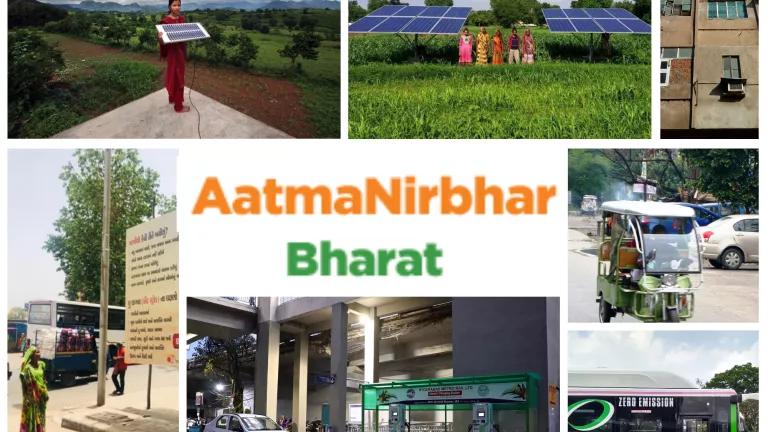Making Bharat Atmanirbhar through Clean Energy
In India, extreme power blackouts have been fanning the flames of a looming energy crisis. Here are three steps India can take toward energy security.

One clear lesson from the global energy crises precipitated by the Russia-Ukraine war is that transitioning away from geographically concentrated fossil fuel resources to more equitably distributed renewable power may lead to a more stable global energy market. In India, where extreme power blackouts have been fanning the flames of a looming energy crisis, power demand is surging even as summer heat makes new records every year. Already heavily dependent on oil imports, India is being pushed into the untenable position of importing more fossil fuels even as prices worldwide have been skyrocketing. Inflation is only rising, disproportionately impacting food budgets of low income communities, such as those in rural areas. To achieve India’s development goals, transitioning to a clean energy-based economy is crucial. Recognizing this, India has been working strategically toward this transition in several ways that could be further strengthened.
Three steps toward energy security for India:
1. Minimize energy demand through efficiency
India is projected to have the largest energy demand of any country by 2040. Maximizing energy efficiency in buildings, appliances, and industry is a key strategy to minimizing energy demand and supporting a clean energy transition. In the next ten years, building energy use is expected to become the largest consumer of electricity in the country. By 2030, India will have added nearly one billion square meters of new commercial floor space. By 2032, electricity demand in both residential and commercial buildings sectors is projected to rise by 5 folds and 3 folds, respectively.
India is already making some headway on building energy efficiency—policies and schemes implemented by India’s Bureau of Energy Efficiency (BEE) have saved an estimated 300 million tons of CO2 emissions. However, a big and simple opportunity remains untapped: implementing building energy codes that set minimum efficiency levels for commercial buildings. NRDC and Administrative Staff College of India estimate country wide implementation of the Energy Conservation Building Code, launched by the BEE in 2007, could avoid 1,065 metric tons of carbon dioxide between 2019 and 2030. Leading states like Telangana have already implemented the code in over 500 large commercial buildings. To fully realize energy efficiency savings potential, more states need to take the lead to ensure energy code compliance across the industry.
2. Electrify transportation
Transitioning to renewable energy powered electric vehicles is a huge growth opportunity for India- the country can save billions of dollars on energy imports, drastically improve air quality, and lead to a greener, more energy secure future. India has one of the lowest vehicle penetration rates of any major economy and thus has a unique opportunity to establish a sustainable electrified transportation system. India has so far recognized this potential. Led by NITI Aayog, India has launched policy initiatives to encourage the development of the EV ecosystem since 2018. Policies as well as consumer support have resulted in significant growth in EV sales- they are now three times the total from 2020-21. The Indian budget for 2022 has also made a big push towards mainstreaming electric mobility.
To fully unlock the billion-dollar opportunity that is powering EVs through renewable energy, several policy levers must be pulled: 1) Make it easier for EV charging providers to procure renewable energy; 2) encourage inter-state trading and transmission of renewable energy to power EVs; and 3) provide power banking facility for energy operators. Investing in renewable energy-powered electric mobility is an essential strategy towards enacting an energy secure future for India: one that has the potential to achieve India’s goals of creating jobs, reducing air pollution, and combating climate change all at the same time.
3. Meet energy demand through locally produced renewable energy and green hydrogen
The current mix of renewable energy in power generation is about 18%. Solar, at an all time high at the end of 2021, generated 68.77 billion units of energy, greater than the total power generated in Switzerland. As the amount of power generated by renewable energy increases, the need to import costly coal should also go down. Green hydrogen, especially for heavy industry like fertilizers, cement and steel, can aid in moving away from fossil fuel dependence on a larger scale. India’s Green Hydrogen Policy has the possibility to be transformative in energy policy—it could produce some of the world’s most affordable green hydrogen. However, to be effective, the policy needs to specify targets and subsidies, and support for implementation needs to be in place.
At the village level, locally generated renewable energy can create local employment opportunities as well as bring the green transition closer to communities. Called decentralized renewable energy (DRE), this locally generated renewable energy is usually small scale and generated close to the point of use. Clean energy solutions led by rural women have been proven to benefit entire households and communities, maximizing the impact of clean energy. Clean energy generation at the village level has been shown to increase energy access and improve livelihoods, as well as help address the ongoing challenges of reliability, quality and affordability of energy in rural areas. Interventions, such as large-scale adoption of decentralized renewable energy, can make clean energy accessible to all while also meeting climate commitments.
With bold climate commitments, India has signaled determination to drastically cut carbon emissions. The world’s uncertain supply chains, increasing power demands, and geopolitical risks in energy supply have only highlighted the urgency of achieving those goals. Times of crisis often lead to transformative change. As global temperatures continue to climb, and the gaps between resource availability and needs continues to widen, a bold and speedy shift towards clean energy is not just important, but necessary: at this point, the clean energy transition is sure way to usher a time of sustainable, India-created energy stability: an Urja Atmanirbhar Bharat.



